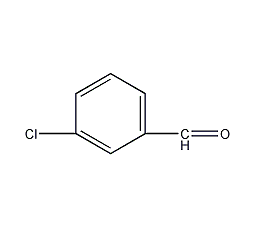
Structural formula
| Business number | 05Z1 |
|---|---|
| Molecular formula | C7H5CLO |
| Molecular weight | 140 |
| label |
3-Chlorobenzaldehyde, 3-Chlorobenzaldehyde |
Numbering system
CAS number:587-04-2
MDL number:MFCD00003350
EINECS number:209-596-9
RTECS number:None
BRN number:507098
PubChem number:24854057
Physical property data
1. Physical property data
1. Properties: colorless or light yellow transparent liquid
2. Density (g/mL, 20/4℃): 1.2410
3. Refractive index (nD20): 1.5641
4. Flash point (℃): 88°C
5. Melting point: 17
6. Boiling point (ºC): 213.5
7. Refractive index at room temperature (n25): 1.561325.8
8. The liquid phase standard claims heat (enthalpy) (kJ·mol-1): -125.9
Toxicological data
None yet
Ecological data
None yet
Molecular structure data
1. Molar refractive index: 37.90
2. Molar volume (cm3/mol): 113.0
3. Isotonic specific volume (90.2K ): 288.2
4. Surface tension (dyne/cm): 42.2
5. Polarizability (10-24cm3): 15.02
Compute chemical data
1. Reference value for hydrophobic parameter calculation (XlogP): None
2. Number of hydrogen bond donors: 0
3. Number of hydrogen bond acceptors: 1
4. Number of rotatable chemical bonds: 1
5. Number of tautomers: none
6. Topological molecule polar surface area 17.1
7. Number of heavy atoms: 9
8. Surface charge: 0
9. Complexity: 103
10. Number of isotope atoms: 0
11. Determine the number of atomic stereocenters: 0
12. Uncertain number of atomic stereocenters: 0
13. Determine the number of chemical bond stereocenters: 0
14. Number of uncertain chemical bond stereocenters: 0
15. Number of covalent bond units: 1
Properties and stability
Chemical properties:
Properties: colorless or light yellow transparent liquid. Boiling point: Soluble in ethanol, ether, benzene and acetone, slightly soluble in water.
Storage method
Storage:
Seal the container and store it in a sealed main container in a cool, dry place.
Synthesis method
Preparation method: Obtained from m-nitrobenzaldehyde through the following steps: Cool the solution of stannous chloride and concentrated hydrochloric acid to 5°C, slowly add m-nitrobenzaldehyde in batches, stir vigorously, and the reaction process will heat up quickly. to about 100℃. Use ice salt bath to cool to about 2℃, and orange-red color will precipitate.��Crystallize to obtain a paste suspension. Add sodium nitrite aqueous solution from below the liquid surface while stirring, keeping the temperature at 0-5°C. Finally, the solution should turn the starch potassium iodide test paper blue. Add this diazonium salt solution to the cuprous chloride solution at 75°C, mix thoroughly, add concentrated hydrochloric acid, mix well, and leave overnight. Carry out steam distillation, collect the distillate, extract with diethyl ether, and dry the extract with anhydrous calcium chloride. Filter, evaporate the ether and then distill under reduced pressure. Collect the 107-109°C (3.47kPa) fraction to obtain the finished product with a yield of more than 75%.
Purpose
Usage: organic intermediate.


